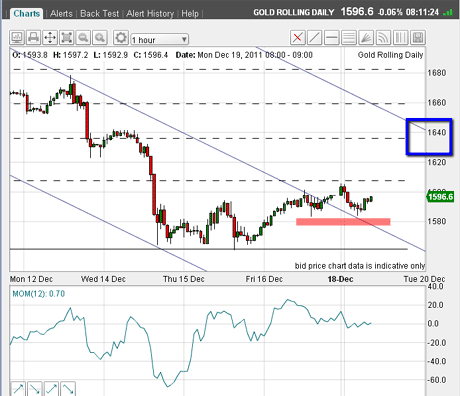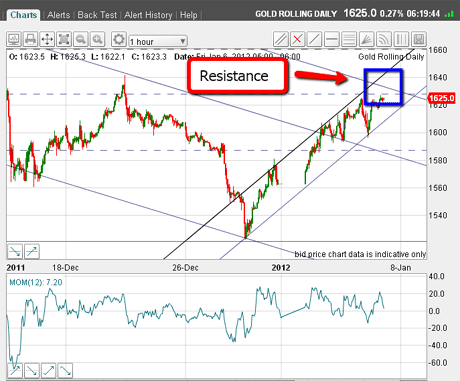Gold hits my target and backs off
John C Burford explains why he trades swings in the gold market, and why strict money management is key.
When I last wrote on gold, I was looking at a relief rally off the 15 December lows and gazing at a probable A-B-C pattern that was forming.
I had an upper target in the $1,640 area, and wrote: "This line meets the Fibonacci 38% retrace level in the $1,640 region. That is the level I will be using as my possible target and where I will be looking to short again, if the market can make it above the 23% level."
Belowis the chart I showed on 19 December.
MoneyWeek
Subscribe to MoneyWeek today and get your first six magazine issues absolutely FREE

Sign up to Money Morning
Don't miss the latest investment and personal finances news, market analysis, plus money-saving tips with our free twice-daily newsletter
Don't miss the latest investment and personal finances news, market analysis, plus money-saving tips with our free twice-daily newsletter
The high for that move turned out to be $1,642. That was an accurate call - and I made that short sale there, using a close stop using my 3% rule.
Following that high, the market promptly declined below the 15 December low to make new lows for the move. I then moved my protective stop down to my entry level, using my break-even rule.
I then had a 'free' ride on this trade a great position to be in.

(Click on the chart for a larger version)
Where should I take profits?
After that $1,642 high was put in, I was then able to search for possible tramlines and here is the result of my search:

(Click on the chart for a larger version)
The centre line is my best fit, and the lower one also fits very well. Note that I have used a previous minor high to anchor the lower tramline. To understand why I use these particular touch-points, have a look at my video tutorials .
I have also drawn in a 'satellite' tramline above the centre one, which takes in the extreme touch-points. Recall in Wednesday's email on the euro, I had to do a similar operation.
As the market moved down, it approached my lower tramline and that was the signal to take profits, as I did in the $1,550 area.
Note also the positive momentum divergence, marked by the green arrows another warning sign that the down-move was getting exhausted.
That was a very nice low-risk swing trade yielding a profit of around $80 per ounce, or 800 pips a profit of £800 per £1 spread bet.
The advantage of swing trading vs long-term
This trade vividly highlights why I like to trade market swings, rather than attempt long-term trades.
Since taking profits on 29 December, the market has rallied by almost $100 right back to the area in which I had shorted! If I had held the short trade anticipating holding for a long-term trade, I would be sitting on zero gain, with the market in rally mode. If this rally continues, I would be sitting on a losing position an unhappy thought!
Although my protective stop would be at break-even, and suffer no loss, psychologically I would have kicked myself for not having taken a great profit when offered at the $1,550 lows.
The best mental state for a trader is after a profit has been taken, and the market can then be viewed calmly while searching for another low-risk trade. If you had just kicked yourself, you would likely be in no mood to view anything calmly!
Gold may be rallying, but I'm still trading the short side
OK, we have a gold rally on our hands here is the close-up of the current situation:

(Click on the chart for a larger version)
I have drawn in a new set of up-sloping tramlines containing the rally. The touch-points are pretty good. But now at the $1,620 area, we are closely approaching the Fibonacci 38% retrace of the move down from the $1,800 high, the down-sloping satellite tramline, and the upper up-sloping tramline.
This area is marked by my 'Resistance' label in the blue box. This is formidable resistance and can be used to set another short trade.
You may ask: Why am I trading from the short side, and not the long side?
Simply because in the bigger picture, it appears we are in third Elliott down waves of several degrees (timescales). I have written about this before, and so far, these patterns have not changed. We are in a major bear market.
It is therefore prudent to trade from the short side, as rallies can reverse sharply as we have seen with the above trade.
But nothing is written in stone in the markets. I am fully prepared to be wrong but any losses I take will be limited by my 3% and break-even rules.
Successful trading is all about taking your trades only when the odds are definitely on your side and no punting! Capital preservation is absolutely the most important driver in your trading.
Watch out for a new video tutorial on my 3% rule, coming soon.
If you're a new reader, or need a reminder about some of the methods I refer to in my trades, then do have a look at my introductory videos:
The essentials of tramline trading
An introduction to Elliott wave theory
Advanced trading with Elliott waves
Don't miss my next trading insight. To receive all my spread betting blog posts by email, as soon as I've written them, just sign up here .
Get the latest financial news, insights and expert analysis from our award-winning MoneyWeek team, to help you understand what really matters when it comes to your finances.
John is is a British-born lapsed PhD physicist, who previously worked for Nasa on the Mars exploration team. He is a former commodity trading advisor with the US Commodities Futures Trading Commission, and worked in a boutique futures house in California in the 1980s.
He was a partner in one of the first futures newsletter advisory services, based in Washington DC, specialising in pork bellies and currencies. John is primarily a chart-reading trader, having cut his trading teeth in the days before PCs.
As well as his work in the financial world, he has launched, run and sold several 'real' businesses producing 'real' products.
-
 Investors will reap long-term rewards from UK equities
Investors will reap long-term rewards from UK equitiesOpinion Nick Train, portfolio manager, Finsbury Growth & Income Trust, highlights three UK equities where he’d put his money
-
 The graphene revolution is progressing slowly but surely
The graphene revolution is progressing slowly but surelyEnthusiasts thought the discovery that graphene, a form of carbon, could be extracted from graphite would change the world. They might've been early, not wrong.